Elias Moses
The founders of the firm of E. Moses & Son were my great-great-great-grandfather Elias Moses (born 1783 in Bungay, Suffolk, died in London 1868) and his son Isaac Moses Marsden.
Isaac Moses, father of Elias and grandfather of Isaac Moses Marsden
Isaac Moses was probably born in Colmar, Alsace, around 1757. He moved to England and settled in Bungay where he had a silversmith’s shop from 1780 to 1789 or 1790. Three sons were born in Bungay, including Elias (1783) and Philip (1786). Philip adopted the surname Moss, and in 2019 his descendant Stephen Moss commissioned the book “From Moses to Moss” by Gill Blanchard.
On 31 August 1803 Elias Moses (aged 20) married Judith Jacobs (1780–1825) at the Great Synagogue, London EC3. They had six children, of whom Isaac was the eldest.
Elias Moses, founder of E. Moses & Son
In 1997 Andrew Godley published an article “The Development of the Clothing Industry: Technology and Fashion”, available here. In 2004 he contributed an entry on Elias Moses in the Oxford Dictionary of National Biography.
Many of the early retailers of ready-made clothing were Jews and, whether they were based in London or the provinces, often came from a background of dealing in secondhand clothes (slops). By the early 1800s slop dealers were often also textile merchants and, inevitably, making up garments on the side. The retailing of these new garments was typically based in the merchant’s warehouse, which doubled as a shop. Indeed, in many of the clothing warehouses tailors might be employed to cut and assemble garments. In the 1820s and 1830s fabric prices fell, and demand for new clothes increased. It was the slop sellers who began to meet the growing demand for cheap standard garments, and clothes retailing became more specialized. In London, in particular, the emergence of high-street stores was obvious, and many of the Jewish former slop sellers moved into the manufacturing and retailing of ready-made clothing….. Elias and Isaac Moses established their partnership, first in Ratcliffe Highway [now Cannon Street Road] in the East End ….
Insurance policies held at the London Metropolitan Archives show that in 1829 E. Moses & Son, clothiers, were at 6 Houndsditch; in 1831 at 18 Bury Street; and in 1832 at 154 Minories. (Thanks to Laura Jones for this information; her paper “The Jewish Pioneers of Mass Market Tailoring” was part of an exhibition “Moses, Mods and Mr. Fish”, at the Jewish Museum, London 2016: this review of the exhibition was in the ‘Jewish Chronicle’. Laura Jones has also kindly given me access to her unpublished 2014 dissertation on E. Moses & Son for the London College of Fashion.)
Andrew Godley continues that E. Moses & Son
profited from the increase in demand for emigrant outfits as migration to Australia surged in the early 1840s. In 1846 the original shop’s floor space was extended fourfold, and then sevenfold, as the Ready-Made Clothing Emporium at Aldgate became the largest shop in London.
This emporium included 154, 155, 156 and 157 Minories, and 83, 84, 85 and 86 Aldgate. Branches of E. Moses & Son in the northern towns of Bradford and Sheffield were opened in 1849. In 1850 a London West End branch was opened on the corner of Hart Street and New Oxford Street, and in 1860 another in Tottenham Court Road.
New shop in Tottenham Court Road
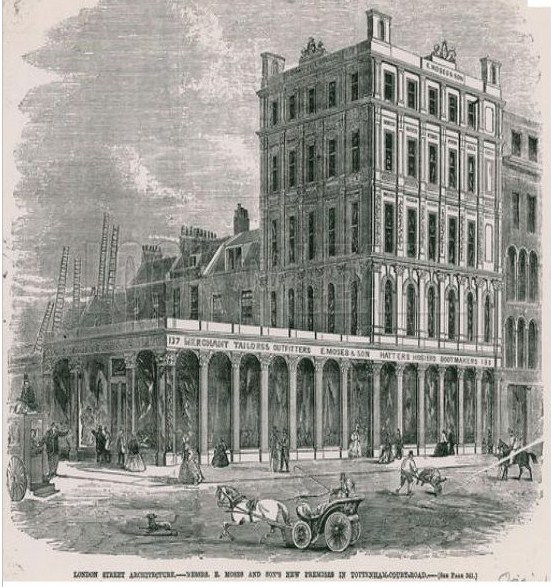
Interior view of Minories shop 1847 by George Frederick Sargent
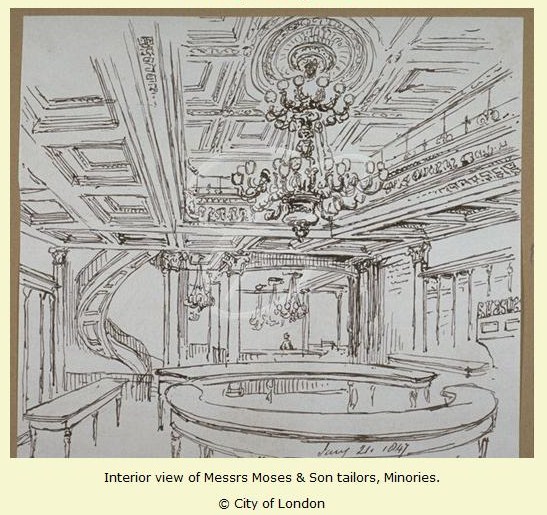
Moses operated on what was still a fairly novel concept of low margins on a high turnover. Success depended on being able to keep the prices low and demand growing. Prices were kept low through a combination of cost-cutting in manufacturing and obtaining discounts on fabrics. The application of the techniques of subdivision and specialization in the manufacturing of standard garments was taken to new lengths by manufacturers of ready-made garments in the 1830s and 1840s. Jobs were generally contracted out to small workshops, where conditions of work prompted cries of outrage by the Christian socialists in the early 1840s…. [The] vast majority of clothes sold in London shops were put out to East End contractors. In 1851 more than a quarter of all the female tailors in England and Wales lived in the East End.
Manufacturing costs were also kept low through forcing fabric producers to pass on sizeable discounts. Textile firms were happy to do this because of the size of orders Moses was able to put through. Indeed, family alliances through marriage ensured that the second largest retailers were brought into the fold, when [in 1827] Isaac married Rachel, the daughter of Hyam Hyams, another Jewish entrepreneur in the ready-made clothing industry…. Rachel died in 1836 and Isaac married on 25 May 1845 Esther Gomes (1825–1908). In 1865 he adopted the additional surname Marsden.
The real legacy of E. Moses & Son to the world of business was in pioneering new marketing techniques. These important innovations all came in the 1840s. First, the emporium itself was designed to attract custom. It had a high classical portico, tall ground-floor windows, and bright interior lighting, and offered impeccable service to any who wandered in. No building was like it in all of London. Second, little expense was spared in advertising the top-quality clothes, available at such cheap prices and only in the emporium. The advertisements were sometimes placed in magazines but usually they were freely distributed throughout London in the form of little booklets. Many of the latter have survived and show that popular current events were used as the basis for a doggerel (probably composed by Isaac) on the emporium’s virtues. Third, clearly displayed fixed prices cut out any haggling and enabled staff to spend their time cultivating the image of a well-to-do West End bespoke tailors by standing in attendance on customers. The firm founded by Elias Moses was one of the most important retailers of ready-made clothing in the latter half of the nineteenth century. The company claimed that 80 per cent of the British population bought such clothing by 1860, which may have been an exaggeration, but not by much. By that time Britain had the most advanced clothing industry in the world and the most sophisticated retail outlets, supported by marketing techniques pioneered by E. Moses & Son. Elias Moses died on 24 January 1868 at 57 Porchester Terrace, Paddington, London; Isaac Moses Marsden died at his home, 4 Kensington Gardens Terrace, London, on 26 July 1884.
There is one glaring point which is omitted in this account. The enormous expansion of E. Moses & Son took place in 1846, just after the marriage in 1845 of Isaac Moses to Esther Gomes Silva. It seems likely that Isaac’s second marriage brought a big injection of capital into the business of E. Moses & Son.
Kathryn Morrison, in “English Shops and Shopping: an Architectural History” (Paul Mellon, 2003), writes:
Ready-made clothing had been available as a minor line of merchandise in shops since the late seventeenth century, but it was only in the 1840s that shopkeepers began to develop large-scale establishments that specialised in ready-made garments - as yet catering almost exclusively for working- and middle-class men, rather than women. The most successful of these enterprising retailers, E. Moses and H. Hyam, were involved in manufacture as well as retailing, and were among the first to develop chain stores.
In the Jewish Virtual Library these notes appear in an article on Tailoring in London around 1850:
As the [Jewish] community grew, efforts were made by the communal authorities to cut down the number of hawkers and to apprentice Jewish youth to trades, particularly tailoring, hat-making, and shoe-making. Thus by 1850 London (perhaps the first large city to do so) had developed an indigenous Jewish artisan class, as well as middle-class clothing entrepreneurs, contractors, and middlemen. By enabling the working classes to buy new clothing in the same styles – although not of the same quality – as those worn by the rich, they began a social revolution. Two firms especially, Hyam, which employed 6,000 people and had a payroll of £200,000 a year, and E. Moses & Son, famous for its advertising techniques, pioneered the new development. These and similar firms supplied outfits for emigrants to the colonies. To supply the needs of these firms small tailoring workshops proliferated, encouraged by the import of the Singer sewing machine in the 1850s and 1860s. The waves of immigrants from Eastern Europe from the 1880s increased the number and concentration of Jews in tailoring.
Jerry White, in “London in the Nineteenth Century” (Vintage, 2008), writes as follows:
The London garment industry … clustered strongly in Stepney (mainly Whitechapel) and Westminster (mainly Soho). The East End was home especially to extreme subdivision of labour and had been so for generations: ‘sweating’ was supposed to have begun around the time of the Napoleonic wars. But it became scientifically organised with the rise of the great Houndsditch ready-made wholesalers in the 1840s and 1850s. A coat required by Messrs Moses, say, or Hyams, would be cut by the hundred in the wholesalers, basted or ‘fitted up’ by the master tailor (the sweater) and sent out to individual homeworkers … There were more homeworkers available in the garment district than work to put out to them, so there was hardly ever a labour shortage……
Gerry Black, in “Jewish London: An Illustrated History” (Breedon Books, 2003), writes that “durable inexpensive clothes of presentable quality and appearance were a phenomenon of the 1840s and 1850s and one that became intimately bound up with the Jewish entrepreneurs. In 1860 E. Moses & Son boasted that it was
the first house in London or may we say in the world that established the system of new clothing ready made. Eighty percent of the population purchased ready made clothing because the prejudice against it had been conquered by the reputation of our firm. Thousands of tailors have followed our example, but we continue in the van.
This 1860 quote is taken from a document now held in the British Museum (thanks to Elish Levi and Ruth Murphy-Arbib for a copy). The document notes the firm’s observation of the sabbath:
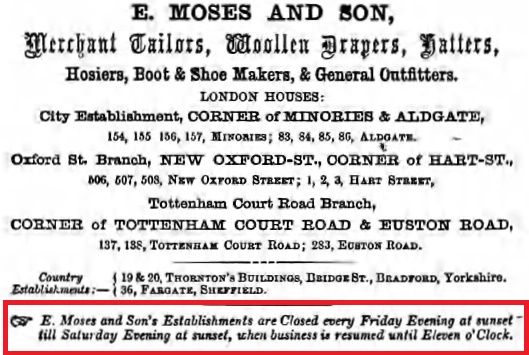
Black continues: “In the 1880s and succeeding decades tailoring was the occupation of more than half of all Jewish working men and women” and “certain aspects of tailoring were considered ‘Jewish’”.
Black also writes about the deplorable working conditions of those in the Victorian clothes trade.
When Jewish tailors went on strike in 1889 they were seeking a 12-hour day; an hour off for dinner; half an hour for tea; and no homework after working hours. And that was for a six-day week. ‘Sweating’ was the word used to describe the cramped workshops unregulated by factory legislation, in which long hours were worked by both master and employees in extremely unsanitary conditions. The Jews were widely blamed for introducing the system. During the late 1880s an anti-sweating movement spread and a House of Lords Select Committee enquired into the matter.
Lloyd Gartner, in “The Jewish Immigrant in England 1870-1914”, cites (pp.84-85) a German observer who in 1876 noted that the labour force of both E.Moses and his competitors was composed of “unfortunates who could not find work in the ‘respectable’ part of the trade’”. But Gartner insists that “clothing outwork did not originate with the Jews, for it possessed a long and unsavoury history”.
Judith Flanders, in “The Victorian City: Everyday Life in Dickens’ London” (Atlantic Books, 2012), comments on the marketing of warm clothes for the state funeral of the Duke of Wellington in November 1852. “Moses and Son, a well-known City firm selling ready-made, inexpensive men’s clothing, produced a rare black-bordered notice:”
E. Moses and Son are in no way desirous of making this a business affair, but, prompted by a disposition to offer every accommodation to their patrons … they have prepared for this occasion a Stock of Mourning Habiliments.
In anticipation of the 1851 Great Exhibition in London, this advertisement was placed on the back cover of Henry Mayhew’s “1851, or, the Adventures of Mr and Mrs Sandboys”. It is here reproduced from Isobel Armstrong, “Victorian Glassworlds: Glass Culture and the Imagination 1830 - 1880” (Oxford University Press, 2008), p.135, referring to the “notorious windows” of E. Moses & Son.
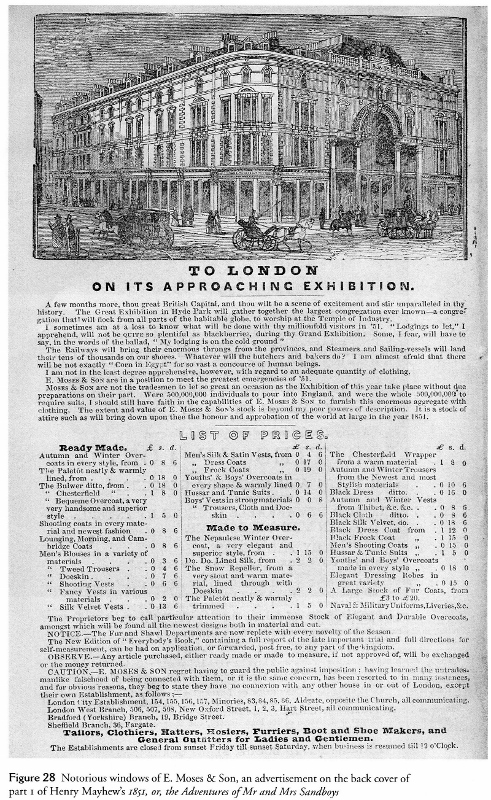
Jon E. Lewis, in “London: The Autobiography” (Robinson, 2009), quotes Max Schlesinger, a German visitor to London in 1853:
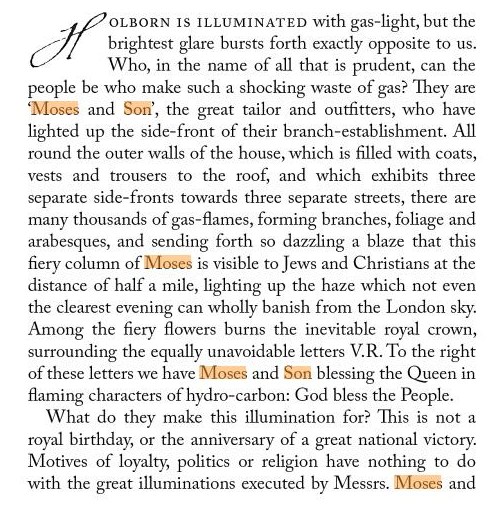

The shop of E. Moses & Son is also described by Liza Picard in “Victorian London: The Life of a City 1840-1870” (Phoenix Books, 2006). Picard notes that since the shop observed the Jewish sabbath, re-opening at sunset on Saturday evening and remaining open until midnight, in winter this “late Saturday opening was made possible by a galaxy of lamps, even one of the first installations of electric light for shop purposes”.
Kathryn Morrison, in “English Shops and Shopping: an Architectural History” (Paul Mellon, 2003), writes:
In 1843 Knight’s ‘London’ described Moses’s ‘extraordinary’ shop on Aldgate: ‘it may be said to reach from the ground to the roof, every storey being fronted by plate-glass and filled with goods’. The shop was enlarged in 1846. and drawings of 1847 reveal that the ornate showrooms were spread over three floors, with a galleried well running through the top two floors…. Instead of having a lantern or skylight, Moses’s well was illuminated by an enormous chandelier - or gasolier - which was suspended over the main counter, with secondary branches lighting the gallery level.
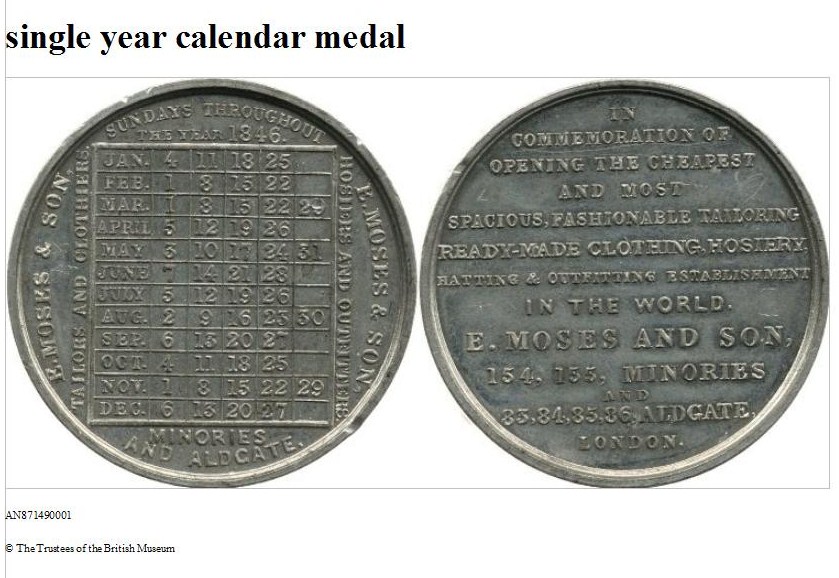
E. Moses & Son and ‘Sweated Labour’
Sheila Blackburn’s book “A Fair Day’s Wage for a Fair Day’s Work? Sweated Labour and the Origins of Minimum Wage Legislation in Britain” (Ashgate Publishing, 2007) begins with a chapter on “The ‘Discovery’ of Sweated Labour, 1843-1850”. It was the publication of Grainger’s 1843 report for the Children’s Employment Commission which drew public attention to the appalling conditions endured by young workers, and Grainger concluded that “there is no class of persons in this country, living by their labour, whose happiness, health, and lives are so unscrupulously sacrificed as those of the young dress-makers.”
Blackburn points out that
the conscience of the nation … was only fully awakened by the publication of Thomas Hood’s Song of the Shirt ….. in the 1843 Christmas edition of … Punch…. [The] poem was based on a real incident - the case of a Lambeth widow named Biddell who, desperate to buy ‘dry bread’ for her two starving infants, pawned the garments she had been sewing. Having been forced to leave a deposit of two pounds for the safe return of the materials entrusted to her, she was plunged into debt. Engels commented on the ‘shameful barbarism’ of this custom whereby impoverished women had no option but to pawn the garments only to redeem them at a loss…..
Biddell (her first name was not given) was subsequently prosecuted by her employer, Henry [Tsebi] Moses of Tower Hill. She blamed overwork and near starvation for not fulfilling her contract…. In court it was claimed that she lived in one room, which was ‘the very picture of wrethchedness’. It was devoid of furniture and quite unfit for human habitation. Biddell was spared the house of correction. But when she and her children were despatched to the workhouse, her employer was publicly excoriated and subjected to a great deal of racial stereotyping….. The Times commented that Henry [Tsebi] Moses ‘like Shylock, “will have his bond”’… Moses complained about being ‘intemperately singled out for vituperation’ and that he had been maligned for ‘the persuasion to which I belong’. He pointed out that, of forty wholesale slopsellers and shirt manufacturers in London, ‘there are no more than three of the Jewish community’, and that his rates were higher than many of the most respectable outfitting houses….. [But] The Times admonished him further for not seeing that ‘being innocent, and being less guilty than others, are two different things’…..
Elias Moses & Son published an advert accompanied by a doggerel verse dissociating themselves (but to no avail) with the company bearing the same surname….. Later, on 4 August 1848, The Times falsely alleged that E. Moses’ Aldgate branch … was guilty of sweating a Lambeth seamstress… The firm protested its innocence but secured only an indifferent apology…
In 1849 the two Moses families would be united by marriage, when Julia (first child of Isaac Moses) married Edward Henry Moses (first child of Henry Tsebi Moses): see timeline for Isaac Moses Marsden.
Blackburn concludes:
The publication of [Hood’s] poem … gave the seamstresses international fame …. It became one of the best-known verses in the English language …. and served as a model for a whole school of international social protest literature…. But the poem did not succeed in ending the hardships of overworked seamstresses …..
The case of Baltimore, USA.
In 2021 I came across this catalog for Spring and Summer 1918.

There seems to be no record of M. Moses & Son, Inc. but Talia Smith has written on “Baltimore’s Garment Industry and the Jewish Community”.
In turn of the century Baltimore, the city’s garment industry was second only to New York City but unlike New York, Baltimore’s garment industry focused predominantly on utilitarian menswear.
The garment industry began to make a name for itself during the Civil War when Baltimore was making uniforms for both the Union and Confederate armies. Called “slop suites” these uniforms came in small, medium, and large but the sizes were not standardized and looked rather sloppy, thus “slop suites.” It was because of this the government began an effort to take measurement statistics and standard sizes were born.
In the early days, the garment industry was dominated by the German Jewish community during their mid 19th century immigration peak. According to historian Isaac M. Fein, “clothing was the major industry in which Jews excelled.” One such German Jewish immigrant, Moses Wiesenfeld, came to Baltimore in 1838 and began a wholesale clothing company in 1849. The company, Moses Wiesenfeld & Co., became the leader of the wholesale garment industry. Baltimore’s garment industry gave Jewish business owners the opportunity to employ within the Jewish communities.
A generation later, Russian Jews … began to enter Baltimore. Between 1881 and 1890, over 24,000 Russian Jews landed in the city. Unfortunately, rifts between German Jews and Russian Jews created tensions within the industry. Because German immigrants were established in Baltimore for longer, many of the German Jewish business owners were hostile towards the more recent immigrants and “exploited their Russian Jewish workers.” In 1901, there were roughly 400 sweatshops in East Baltimore which mainly employed Russian immigrants.
Like most sweatshops, the conditions in these factories were dangerous and the work grueling. The downtown area of Baltimore did not have electricity until 1881, so before that, not only were the factories hazardous, they were dark and all work was to be done by hand. In addition, the garment industry was a family affair. During the early years, men would cut fabric in the factories, bring them home for their wives to sew, and finally bring the pieces back to the factory for finishing touches. Eventually, women and children joined the men inside the factories to centralize the business. It is estimated that 20% of all the city workers worked in the garment industry in the early 20th century, a majority of those Jewish…
World War One was great for the menswear business and Baltimore thrived by making uniforms and contributing to the war effort. The Great Depression hit in 1929 and by 1931 one of the major garment factories in Baltimore, Henry Sonneborn & Co, closed its doors. Despite that, work was relatively stable for the factory worker. In the mid thirties, shops began to unionize, slowly improving conditions within the factories. While the industry peaked during the Great War, the second World War saw its demise. Unfortunately, Baltimore’s Garment industry lacked government orders during World War Two, resulting in the industry taking a major hit from which it would not recover.
E. Moses & Son adverts in publications of Charles Dickens
This advertisement appeared in an edition of ‘Oliver Twist’ published in 1846:
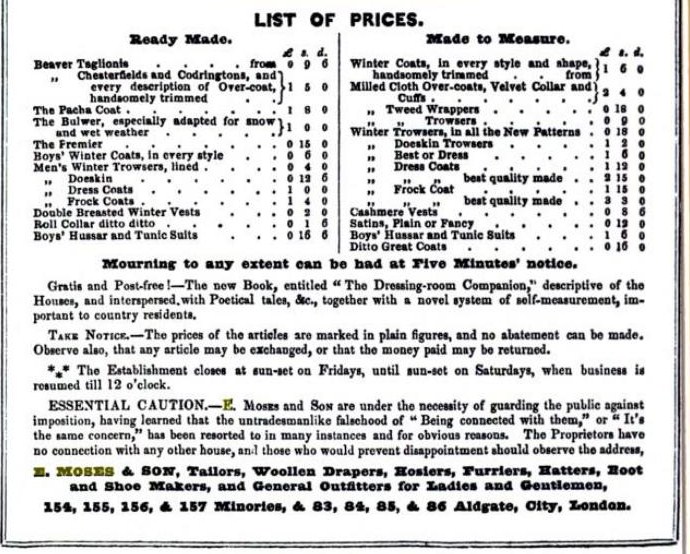
In “David Copperfield Without the Dickens” (in “Fine Books & Collections”, Jan/Feb 2006, pp 34-35), Paul Collins writes:
The Durrant facsimile’s fidelity to these one-shilling originals is why, before you even embark upon the adventures of young David, not to mention Peggoty and Ham, you discover …. a whole other tale of Dickensian England ….[including] a brilliant Jewish tailor and his son.
Not the novel, you understand. The ads…. A typical monthly installment had at least a dozen pages of closely set ads, not to mention inserted foldout catalogs … Page to the end of one installment of David Copperfield … and you find the mercantile poetry that once charmed sovereigns away from hardworking Englishmen. And I do mean poetry: the inside back cover of every issue of David Copperfield featured an advertisement in verse by E. Moses & Son, Tailors. The store actually retained its own poet… The poems always end with the triumphant splendiferousness of Moses & Son clothing, before proceeding to such useful particulars as “MOURNING TO ANY EXTENT AT FIVE MINUTES’ NOTICE”……
But if you seek a family saga in this book, Moses & Son might be it. London clothier Elias Moses was the first to pioneer a retail model of massive advertising and deep discounts to create a high-volume business in low-margin ready-to-wear clothing. Even the Duke of Wellington could not escape the flood of Moses ad circulars. (“The Duke has every reason to be satisfied with his own tailor”, a note sent back harrumphed.) The Moses & Son store even looked different, fitted with then unheard of plate-glass display windows out front and fixed prices on clothing inside. But after the father passed away, and the son retired, the store rather lost its heart. When the son of Moses & Son died in 1884, the Times of London mourned, “The large premises at Aldgate and Oxford-street know the name of ‘E. Moses and Son’ no more.”
And yet there they are, in their prime and gloriously unaware of the future, at the back of every issue in 1849 and 1850.
In 1852 this advertisement appeared in an edition of ‘Bleak House’:

E. Moses & Son booklets
“The Dressing-Room Companion” was published in 1847 and is held in the Jewish Museum, London, together with another booklet “The Treasury of Taste”.
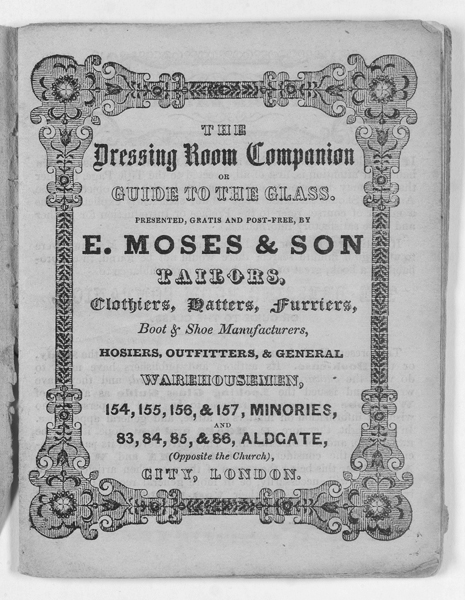
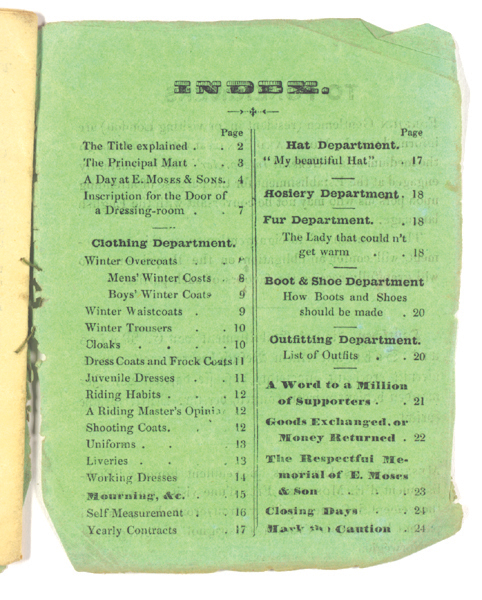
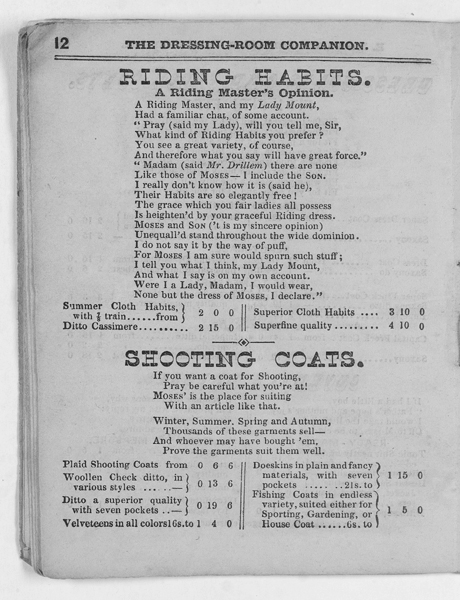
The Guildhall Library in London has what their enquiry service describes as “a veritable bounty of material within our collections on the subject of the Moses clothing business. In the Guildhall Library Printed Books Dept are the following booklets, all published by Elias Moses and Son:
THE DRESSING ROOM COMPANION. OR GUIDE TO THE GLASS , 1848 (23 pages)
FASHIONS FAVOURITE OR THE MART OF THE MANY. 1847 (23 pages)
THE TREASURY OF TASTE AND THE UNIVERSAL WAREHOUSE. 1849 (23 pages)
THE LIBRARY OF ELEGANCE. 1852 (24 pages)
NEW SUMMER DRESS AT THE NEW HOUSES. c.1870 (single sheet of advertising)
“In the Prints and Maps Dept the following items might be of interest:
Trade card of E.Moses and Son dated Oct 1849 (poem, decorative border but no pictures)
Two small wood engravings of the shopfront at 157 Minories showing Moses’ shop sign, Noble collection A416/9
Two small wood engravings of the shop front 85-86 Aldgate showing Moses’ shop sign. Noble collection A10/1
Three pen and ink sketches showing the interior (2) and exterior (1) of the shop in the 1840’s. Sargent Collection
“And possibly the best item:
THE PRIDE OF LONDON - a description of the Moses emporium, inside and out, in verses. 32 pages, with illustrations c.1850.”
An online catalogue for the Guildhall Library material on Elias Moses is available here.
Thackeray’s poem about E. Moses & Son
In 1848 William Makepeace Thackeray published the poem ‘Mr Smith and Moses’, as recalled in ‘The Times’ on 11 August 1884:

King Louis Philippe of France, having abdicated during the February 1848 Revolution and “fearful of what had happened to Louis XVI…. quickly left Paris under disguise. Riding in an ordinary cab under the name of ‘Mr. Smith’, he fled to England.”
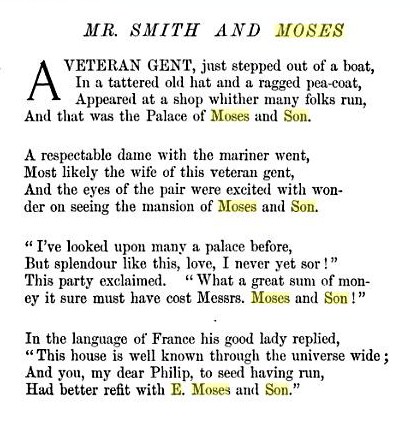
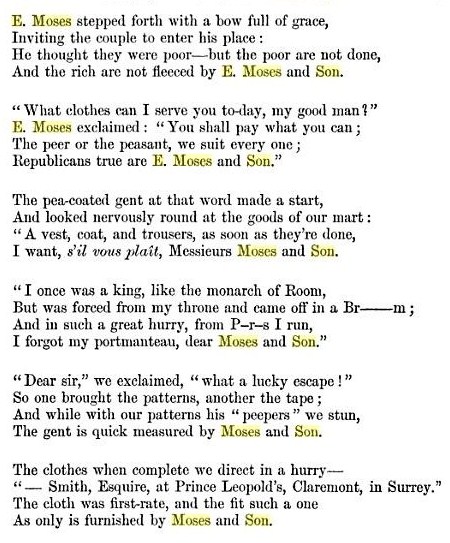
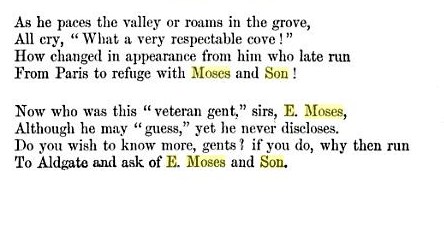
Was Karl Marx a customer of E. Moses & Son?
In his superb biography of Karl Marx (Fourth Estate, 2000), Francis Wheen writes (on page 342) about Marx’s appearance at the 1872 Congress of the International in The Netherlands:
The Hague congress opened in a mood of conspiratorial frenzy at the inappropriately named Concordia Hall. There were sixty-five delegates but many more reporters, spies and curious sightseers who came to gaze at the dangerous revolutionaries as if they were lions in a circus. A Belgian newspaper broke the sad news to its readers that Dr Marx, godfather of terrorism and chaos, looked like a ‘gentleman farmer’. And a Dutch journalist wrote that ‘The impression he makes in his grey suit is exactly comme il faut. Anyone who did not know him and had no connection with the nightmare of the feared International would take him for a tourist making a sortie on foot.’
The papers of Marx and Engels contain an invoice “L 5075. E. Moses & Son (London). 1871. 1 Brief (= Rechnung)” - suggesting a possible source of Karl Marx’s grey suit.
The End of E. Moses & Son
Many people have asked me to explain the demise of this enterprise. But having been established in 1829 it did trade for over 50 years, and as Laura Jones has written “the Jewish tailoring firms of E. Moses & Son and Hyam & Co pioneered many of the principles upon which men’s high street fashion was founded” (“The Jewish Pioneers of Mass-Market Tailoring in the 19th Century”, in “Moses Mods and Mr. Fish”, Jewish Museum London, 2016). The same booklet, accompanying a recent exhibition at the Jewish Museum, includes chapters on Montague Burton (born Meshe David Osinsky) and Cecil Gee (born Sasha Goldstein), who arrived in the UK from Lithuania (then part of the Russian empire) in respectively 1900 and 1913.
Certainly (as the Times obituary suggests) it was the son, Isaac Moses Marsden, who was almost certainly the creative driving force behind the business, and having made his initial fortune in the clothing trade Isaac moved on to other activities such as property - certainly by the late 1850s when he took part in the St Johns Wood auction.
Isaac Marsden had many children but relatively few sons, some of whom did take part in managing the firm but none of whom was a natural successor. Montague was engaged in the business at the time of the 1861 census, but by 1871 he had (like his father) moved on to other things and by 1876 was a stockbroker. In his 1877 will Isaac provided for Maurice and Rodolph to take over the shops in Tottenham Court Road and Oxford Street. In a codicil of 1880 these provisions were revoked because those businesses had been “completely wound up”. In September 1879 an advert taken out by Isaac in ‘The Daily News’, entitled ‘Great Clearaance Sale’, said that “E. Moses and Son are retiring from business in consequence of the continued ill health of the principal proprietor”. (Thanks to Laura Jones for this information.)
Another factor was that following the death in 1880 of Madeline Marsden/Fallek, Maurice and his wife assumed responsibility for her 6 children in Paris: see Marsdens in France. Isaac then arranged for Rodolph and Stephen to carry on the business of E.Moses & Son, now just the shop in the Minories, and this is mentioned as late as a codicil of 1883. A few years later when Rodolph (who had started another business as flour merchant) became bankrupt it was stated in court that “the firm of E. Moses & Son …. was dissolved in 1883” (The Times, 5th May 1888). The 1884 obituary of Isaac Moses Marsden (in ‘The Times’ but citing the ‘Jewish Chronicle’) says:
The glories of the house departed on the withdrawal of Mr. Marsden’s active participation in the business, and the large premises at Aldgate and Oxford-street know the name of ‘E. Moses and Son’ no more.
Page last updated 26 Oct 2025.